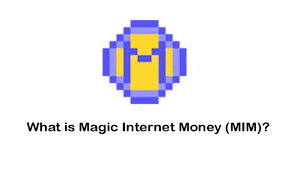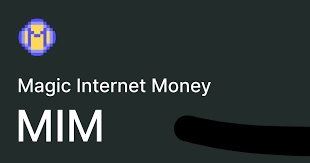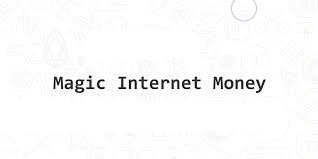Magic Internet Money: DeFi Potential with Stablecoin Innovation
Table of Contents

Magic Internet Money is a Mineable Token. Are you curious about expanding your crypto portfolio with other mineable tokens or alternative coins? At Niftyfinances, you’ll find in-depth information, guides, and the latest updates on various promising crypto projects. Whether you’re a miner or an enthusiast looking for unique opportunities, Niftyfinances is your go-to platform to discover what’s next in the world of decentralized finance!
In the rapidly evolving world of decentralized finance (DeFi), Magic Internet Money (MIM) emerges as a groundbreaking stablecoin, offering users the ability to unlock liquidity from interest-bearing assets. By utilizing platforms like Abracadabra.money, MIM enables the minting of a USD-pegged stablecoin through the collateralization of yield-generating tokens. This approach not only enhances capital efficiency but also broadens the horizons for DeFi participants seeking stability and flexibility in their financial strategies.

What is Magic Internet Money (MIM)?
Magic Internet Money (MIM) is a decentralized, collateral-backed stablecoin that is pegged to the US Dollar (1 MIM = 1 USD). It operates within the Abracadabra.money ecosystem, a decentralized finance (DeFi) protocol that allows users to mint MIM by collateralizing interest-bearing tokens or other cryptocurrency assets. The goal of MIM is to provide a stable and versatile medium of exchange that can be used across various DeFi platforms, including lending, trading, and staking.
- Decentralized Stablecoin:
- Unlike centralized stablecoins like USDT or USDC, MIM is fully decentralized. It is minted directly by users in exchange for locking up cryptocurrency collateral through smart contracts.
- Collateral-Backed:
- To mint MIM, users must deposit collateral in the form of interest-bearing tokens (ibTKNs) or other supported assets like ETH, BTC, or yield-earning tokens from protocols like Yearn Finance or Curve.
- Pegged to the US Dollar:
- MIM maintains its value through over-collateralization, algorithmic stability mechanisms, and market demand, ensuring its price remains near $1.
- Interoperability Across Chains:
- MIM is available on multiple blockchain networks, including Ethereum, Avalanche, Fantom, Arbitrum, and Binance Smart Chain (BSC), making it highly versatile and accessible for DeFi users across ecosystems.
- Flexible Use Cases:
- MIM can be used for trading, borrowing, staking, liquidity provision, or simply as a stable store of value in the volatile crypto market.
- It is widely supported by DeFi platforms, including Curve Finance, SushiSwap, and other liquidity pools.
- Low Minting Fees:
- Users mint MIM by collateralizing assets at competitive fees, which makes it cost-efficient to obtain stablecoins without needing to sell their crypto holdings.

How Magic Internet Money Works
- Abracadabra.money Platform:
- Users interact with the Abracadabra.money platform to deposit collateral and mint MIM. The protocol uses a unique model of accepting interest-bearing tokens (ibTKNs) as collateral, which are tokens representing assets staked in yield-earning protocols.
- Minting Process:
- Users deposit ibTKNs or other cryptocurrencies into the Abracadabra smart contracts.
- Based on the value of the collateral and a loan-to-value (LTV) ratio, users can mint a specific amount of MIM. For example, if the LTV is 75%, you can mint $75 worth of MIM for every $100 of collateral.
- Repayment:
- To unlock collateral, users repay the MIM they borrowed, plus a small stability fee. Until then, the collateral remains locked in the protocol.
- Liquidation Protection:
- If the value of the collateral falls below a certain threshold, it may be liquidated to ensure the protocol’s solvency. This mechanism protects MIM’s peg and overall stability.

Understanding Magic Internet Money (MIM)
Magic Internet Money (MIM) is a decentralized stablecoin pegged to the US Dollar. It serves as a powerful tool for decentralized finance (DeFi) users seeking a stable, versatile, and trustless medium of exchange. Here’s an in-depth look at what makes MIM unique and how it integrates into the broader DeFi ecosystem.
Definition and Purpose of MIM
Magic Internet Money (MIM) is a USD-pegged stablecoin that maintains its value at 1 MIM ≈ 1 USD. Unlike traditional fiat-backed stablecoins, MIM is:
- Collateral-Backed: MIM is issued by locking up cryptocurrency as collateral in Abracadabra.money, a decentralized lending protocol.
- Decentralized: Unlike centralized stablecoins like USDT or USDC, MIM operates trustlessly via smart contracts, reducing reliance on intermediaries or centralized entities.
- Blockchain-Agnostic: MIM is interoperable and available on multiple blockchain networks, including Ethereum, Avalanche, Fantom, Arbitrum, and Binance Smart Chain, making it accessible across diverse DeFi ecosystems.
Purpose of MIM
The primary goal of MIM is to provide users with a stable and versatile asset for DeFi applications, enabling them to:
- Borrow liquidity without selling their cryptocurrency holdings.
- Hedge against market volatility.
- Utilize MIM as a stable trading pair or in liquidity pools for yield generation.
The Role of MIM Within the Abracadabra.money Ecosystem
MIM is a core component of Abracadabra.money, a decentralized lending platform that leverages interest-bearing tokens (ibTKNs) as collateral.
Magic Internet Money (MIM) Mining
Magic Internet Money (MIM) does not involve mining. Unlike cryptocurrencies like Bitcoin that rely on mining (Proof of Work) or others that use Proof of Stake mechanisms, MIM is a stablecoin designed to maintain a 1:1 peg to the US dollar.
Instead of mining, MIM is minted (created) through a process on the Abracadabra.money platform. Here’s how it works:
- Minting Process: Users deposit interest-bearing tokens (ibTKNs) as collateral into Abracadabra.money’s lending protocol.
- Once the collateral is locked, the user can mint MIM tokens based on the value of their collateral.
- This makes it a collateral-backed stablecoin, similar to other DeFi stablecoins like DAI.
So, rather than mining, MIM is created through collateralization in the DeFi ecosystem.
Magic Internet Money (MIM) itself cannot be staked because it is a stablecoin rather than a governance or yield-generating token. However, you can use MIM in staking-related activities within the Abracadabra.money ecosystem and other DeFi platforms.
Here’s how staking relates to MIM and its ecosystem:
1. Staking SPELL Tokens (Governance Token of Abracadabra.money)
- While MIM itself isn’t stakable, you can stake SPELL, the governance and utility token of Abracadabra.money.
- SPELL staking benefits:
- Stakers receive a portion of the protocol’s revenue.
- Earn rewards generated from borrowing fees, interest, and liquidation fees on Abracadabra.money.
- Voting rights in governance decisions.
2. Yield Farming with MIM
- While Magic Internet Money isn’t directly staked, you can provide liquidity in pools (e.g., on Curve, SushiSwap, or other DeFi platforms).
- Example: Pair MIM with other stablecoins or tokens in liquidity pools to earn rewards and transaction fees.
3. DeFi Opportunities for MIM Holders
Magic Internet Money can be used for:
- Collateralized Staking: You can stake interest-bearing tokens to mint MIM, enabling access to other DeFi opportunities while retaining ownership of your collateral.
- Lending and Borrowing: Earn interest by supplying MIM to lending platforms or use it for leveraged trading.
How MIM is Minted
- Collateralization:
- Users deposit collateral in the form of yield-generating assets, such as interest-bearing tokens (ibTKNs) from protocols like Yearn Finance or Curve Finance. These tokens represent staked assets that earn passive income.
- Other supported collateral types include cryptocurrencies like ETH, BTC, and stablecoin derivatives.
- Minting MIM:
- Based on the value of the collateral, users can mint MIM. The amount of Magic Internet Money is determined by a loan-to-value (LTV) ratio, which ensures the system is over-collateralized to maintain stability.
- Repayment:
- Users repay their borrowed Magic Internet Money, along with a small stability fee, to unlock their collateral. Until repayment, the collateral remains locked within Abracadabra’s smart contracts.
The Mechanics Behind Magic Internet Money (MIM)
Magic Internet Money (MIM) is designed as a decentralized and collateral-backed stablecoin, which relies on robust mechanisms to maintain its stability and usability in the DeFi ecosystem. Below is an explanation of how MIM works, from its collateralization process to the systems in place for maintaining its USD peg.
Collateralization Process
Magic Internet Money is minted through a process that locks cryptocurrency assets as collateral within the Abracadabra.money protocol. The unique aspect of this process is the use of interest-bearing tokens (ibTKNs) as collateral, which adds a yield-generating dimension to the stablecoin minting system.
Utilizing Interest-Bearing Tokens (ibTKNs) as Collateral
- What Are ibTKNs?
- Interest-bearing tokens represent staked assets in other DeFi protocols that generate yield. For example, when you stake DAI in Yearn Finance, you receive yDAI, an interest-bearing version of DAI.
- These ibTKNs retain their original value while accruing additional yield over time.
- Why Use ibTKNs?
- By accepting ibTKNs as collateral, Abracadabra.money allows users to earn a yield on their locked assets while simultaneously borrowing MIM. This creates a dual benefit: liquidity (via MIM) and passive income (from ibTKN yield).
Steps to Mint MIM Through Abracadabra.money
- Deposit Collateral:
- Users deposit supported assets like ibTKNs or cryptocurrencies (e.g., ETH, BTC) into Abracadabra.money’s smart contracts. These assets are locked as collateral.
- Determine Borrowing Capacity:
- The protocol calculates the amount of MIM that can be minted based on the collateral’s value and the loan-to-value (LTV) ratio.
- For instance, with an LTV of 75%, a user can mint $75 worth of MIM for every $100 worth of collateral deposited.
- The protocol calculates the amount of MIM that can be minted based on the collateral’s value and the loan-to-value (LTV) ratio.
- Mint MIM:
- After the collateral is locked, users mint MIM directly into their wallets. The minted MIM can then be used for trading, staking, or other DeFi activities.
- Repay Loan to Unlock Collateral:
- To retrieve the collateral, users repay the borrowed MIM along with a small stability fee. Until the loan is repaid, the collateral remains locked.
- Liquidation Mechanism:
- If the value of the collateral falls below a specific threshold, the position is liquidated to ensure protocol solvency. Liquidation thresholds are slightly lower than the LTV ratio, creating a buffer for price fluctuations.
Maintaining the USD Peg
A critical aspect of MIM’s design is ensuring its stability and maintaining a 1:1 peg to the US Dollar. This is achieved through a combination of algorithmic mechanisms, collateralization, and market incentives.
Mechanisms Ensuring MIM’s Stability Relative to the US Dollar
- Over-Collateralization:
- MIM is backed by collateral that exceeds the amount of MIM in circulation. This ensures that even during market downturns, there is sufficient value locked in the protocol to maintain the peg.
- Liquidation Protection:
- If the collateral-to-loan ratio drops below a certain threshold, the protocol automatically liquidates positions to cover the issued MIM. This liquidation process safeguards MIM’s backing and ensures stability.
- Arbitrage Opportunities:
- If MIM deviates from its $1 value, market participants are incentivized to bring the price back to peg through arbitrage:
- If MIM > $1: Users can sell MIM on the open market for a profit, increasing supply and bringing the price back to $1.
- If MIM < $1: Users can purchase MIM below $1 and use it to repay loans or mint new MIM at $1 value, reducing supply and pushing the price back to $1.
- If MIM deviates from its $1 value, market participants are incentivized to bring the price back to peg through arbitrage:
- Integration with DeFi Ecosystem:
- MIM is widely used in liquidity pools and lending platforms. These integrations help maintain its liquidity and demand, further stabilizing its value.
Omnichain Capabilities of Magic Internet Money (MIM)
Magic Internet Money (MIM) distinguishes itself in the DeFi space by offering powerful omnichain capabilities, allowing users to seamlessly interact with multiple blockchain networks. These capabilities make MIM highly interoperable, expanding its usability and appeal across decentralized ecosystems.
Cross-Chain Functionality
MIM operates as a cross-chain stablecoin, ensuring accessibility and liquidity across numerous blockchain platforms. This omnichain presence provides users with flexibility and opportunities to leverage MIM in a wide variety of decentralized applications (dApps) and DeFi protocols.
Overview of MIM’s Presence Across Multiple Blockchain Networks
MIM is available on several leading blockchains, including:
- Ethereum
- Avalanche
- Fantom
- Arbitrum
- Binance Smart Chain
- Polygon
- And others.
This cross-chain presence enables users to:
- Access MIM on their preferred blockchain ecosystem.
- Transfer MIM across blockchains using bridges or native solutions.
- Participate in DeFi protocols on various platforms while utilizing a single, stable asset.
Benefits of Omnichain Operability for Users
- Enhanced Accessibility:
- Users can easily acquire and use MIM regardless of the blockchain network they prefer, making it a universal asset in the DeFi space.
- Interoperability in DeFi:
- MIM can be used seamlessly in liquidity pools, lending platforms, and decentralized exchanges across different networks, broadening its utility.
- Reduced Fragmentation:
- Omnichain operability ensures that MIM holders are not confined to a single network, preventing liquidity fragmentation and improving market efficiency.
- Cost Optimization:
- Users can choose networks with lower transaction fees (e.g., Avalanche or Fantom) while still benefiting from MIM’s stability and interoperability.
Beaming with LayerZero’s OFT Standard
To further enhance its cross-chain functionality, Magic Internet Money leverages LayerZero’s Omnichain Fungible Token (OFT) standard. The introduction of the Beaming feature simplifies cross-chain transfers and takes MIM’s interoperability to the next level.
Introduction to the Beaming Feature for Cross-Chain Transfers
Beaming is a feature integrated with LayerZero’s OFT protocol, enabling users to send MIM between supported blockchains natively. Key aspects include:
- Streamlined Cross-Chain Transfers:
- Beaming eliminates the need for traditional bridges, which often require manual steps and are prone to delays or vulnerabilities.
- Seamless User Experience:
- With Beaming, users can effortlessly transfer MIM across networks in just a few clicks, without worrying about technical complexities or additional costs.
- Decentralized Security:
- LayerZero’s decentralized architecture ensures that cross-chain transfers remain secure and trustless.
Advantages of LayerZero’s Omnichain Fungible Token (OFT) Standard
LayerZero’s OFT standard brings several benefits to MIM’s omnichain functionality:
- True Interoperability:
- The OFT standard treats MIM as a single asset across all supported networks. Instead of relying on wrapped tokens, the native MIM token is interoperable across chains, simplifying usability.
- Cost Efficiency:
- Unlike traditional bridges, which involve higher gas fees and intermediary costs, OFT-based transfers are optimized for lower fees, saving users money during cross-chain interactions.
- Improved Liquidity Management:
- With OFT, liquidity remains unified across chains, avoiding fragmentation. This ensures deep liquidity pools and efficient trading opportunities for users.
- Security and Reliability:
- LayerZero employs decentralized security mechanisms, reducing the risks associated with cross-chain transfers, such as bridge exploits or token mismanagement.
- Enhanced Developer Integrations:
- Developers building DeFi protocols across multiple blockchains can easily integrate MIM’s omnichain functionality using the OFT standard, ensuring compatibility with the broader DeFi ecosystem.
Use Cases and Applications of Magic Internet Money (MIM)
Magic Internet Money (MIM) stands out as a highly versatile stablecoin in the DeFi ecosystem. Its unique structure and omnichain capabilities allow it to be integrated into a wide range of financial applications, empowering users to maximize capital efficiency, participate in yield farming, and provide liquidity across decentralized platforms.
Enhancing Capital Efficiency
Magic Internet Money is designed to help users unlock liquidity from idle or interest-earning assets, enabling them to optimize asset utilization across DeFi platforms.
Strategies for Leveraging MIM to Optimize Asset Utilization
- Collateralized Borrowing:
- Users can lock interest-bearing tokens (ibTKNs) such as yDAI or aUSDC as collateral in Abracadabra.money to mint MIM. This allows them to access liquidity while still earning yield on their locked assets.
- For instance, a user holding yETH (yield-bearing ETH) can mint MIM, trade or stake it, and retain the interest earned from the yETH collateral.
- Leveraged Yield Strategies:
- Borrowing MIM enables users to reinvest the funds into other DeFi opportunities, such as staking in yield farms, buying additional collateral, or participating in liquidity pools.
- This creates a looping strategy, where users borrow MIM, reinvest, and lock the resulting yield-bearing tokens to mint even more MIM.
- Portfolio Diversification:
- By using MIM to unlock liquidity, users can diversify their investments without selling their original holdings. For instance, an ETH holder can mint MIM, then purchase BTC or participate in DeFi protocols while retaining exposure to ETH.
Examples of DeFi Protocols and Platforms Integrating MIM
- Curve Finance:
- MIM is commonly found in liquidity pools on Curve, paired with other stablecoins such as USDT, DAI, and USDC. Users can earn rewards by providing liquidity to these pools.
- Yearn Finance:
- MIM holders can deposit their stablecoins into Yearn Finance vaults to earn optimized yields through automated strategies.
- Abracadabra.money:
- As MIM’s native platform, Abracadabra.money is the primary protocol for minting MIM and engaging in strategies such as leveraged staking and looping.
- SushiSwap:
- MIM is used in decentralized exchanges (DEXs) like SushiSwap, where users can trade, provide liquidity, and farm rewards.
- Aave and Compound:
- MIM is integrated into lending and borrowing platforms, enabling users to earn interest or access liquidity.
Magic Internet Money (MIM) represents a significant advancement in the DeFi landscape, providing users with a stable, USD-pegged asset that unlocks liquidity from interest-bearing tokens. Through its innovative collateralization mechanisms and omnichain capabilities, MIM offers a versatile tool for DeFi participants aiming to enhance capital efficiency and explore diverse financial strategies. As the ecosystem continues to evolve, MIM’s commitment to security, interoperability, and community-driven development positions it as a cornerstone in the future of decentralized finance.